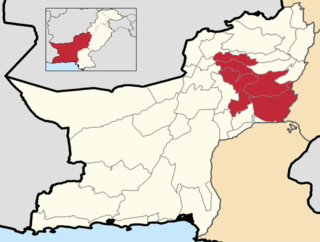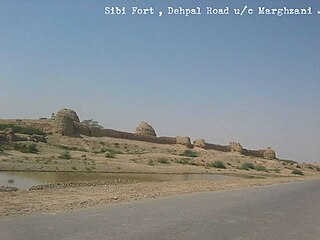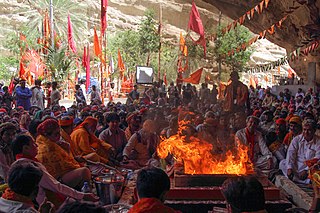Related Research Articles

Balochistan is one of the four provinces of Pakistan. It is the largest province in terms of land area, forming the southwestern region of the country, but is the least populated. Its provincial capital and largest city is Quetta.

Kalāt or Qalāt, historically known as Qīqān, is a historical town located in Kalat District, Balochistan, Pakistan. Kalat is the capital of Kalat District and is known locally as Kalat-e-Brahui and Kalat-e-Sewa.

Makran, mentioned in some sources as Mecran and Mokrān, is the coastal region of Baluchistan. It is a semi-desert coastal strip in Balochistan, in Pakistan and Iran, along the coast of the Gulf of Oman. It extends westwards, from the Sonmiani Bay to the northwest of Karachi in the east, to the fringes of the region of Bashkardia/Bāšgerd in the southern part of the Sistān and Balučestān province of modern Iran. Makrān is thus bisected by the modern political boundary between Pakistan and Iran.

The Baloch or Baluch are an Iranian people who live mainly in the Balochistan region, located at the southeasternmost edge of the Iranian plateau, encompassing the countries of Pakistan, Iran and Afghanistan. There are also Baloch diaspora communities in neighbouring regions, including in India, Turkmenistan and the Arabian Peninsula.

The Brahui, Brahvi or Brohi, are an ethnic group principally found in Balochistan, Pakistan. They speak the Brahui language, which belongs to the Dravidian language family, although ethnically they tend to identify as Baloch.

The history of Balochistan began in 650 BCE with vague allusions to the region in Greek historical records. Balochistan is divided between the Pakistani province of Balochistan, the Iranian province of Sistan and Baluchestan and the Afghan region of Balochistan. Prehistoric Balochistan dates to the Paleolithic.

Kachhi District or Kacchi, known until 2008 as Bolan, is a district in central Balochistan, Pakistan. The Bolan area remained under one district Kacchi until 31 December 1991. The Deputy Commissioner's office started functioning on 17 May 1992, and Bolan became one of the four districts of Naseerabad Division, until the abolition of Divisions in 2000.

Sibi is a district in the Balochistan province of Pakistan. The main mountain ranges are Zen, Bambore and Dungan. The climatic and topography of Sibi District is quite varied compared to other districts of Balochistan. It is also known as the "Hot spot" of Pakistan where the temperatures in the summer exceed 52.6 °C (126.7 °F). Until 2013 the district had two sub-divisions, Sibi and Lehri, further organized into Tehsils and sub-tehsils: Sibi, Lehri, Kutmandi and Sangan. Lehri was rejoined with Sibi district in 2018.
Sibi is a city situated in the Balochistan province of Pakistan. The city is the headquarters of the district and tehsil of the same name.

Las Bela was a princely state in a subsidiary alliance with British India which existed until 1955. The state occupied an area of 18,254 km2 (7,048 sq mi) in the extreme southeast of the Balochistan region, with an extensive coastline on the Arabian Sea to the south. Las Bela was bordered by the princely states of Kalat and Makran to the north and west. To the east lay the province of Sind and to the southeast lay the Federal Capital Territory around the city of Karachi.
Kach Gandava or Kachi is a low-lying flat region in Balochistan, Pakistan separating the Bugti hills from those of Kalat. Until the end of the 15th century the district had been a dependency of Sindh Around 1500 it was taken by Shah Beg of the Arghun Dynasty from Samma Dynasty of Sultan Of Sindh and so came under the control of Kandahar.Soon the territory was conquered by the Kalhoras Amirs of Sindh, they were displaced by the Nadir Shah of Persia and made it the part of Kalat Khanate in 1740. Kachhi was notified as a district on February 1965. At that time Naseerabad, Jhal Magsi and Jafarabad districts were included, these were separated in 1987. It is driven, like a wedge, into the frontier mountain system and extends for 150 miles from Jacobabad to Sibi, with nearly as great a breadth at its base on the Sindh frontier. The soil is fertile wherever it can be irrigated by the floods brought down from the surrounding hills; but much of the central portion is sandy waste. It is traversed by the North-Western railway.

The four provinces, capital territory and two autonomous territories of Pakistan are subdivided into 37 administrative "divisions", which are further subdivided into districts, tehsils and finally union councils. These divisions were abolished in 2000, but restored in 2008. The divisions do not include the Islamabad Capital Territory or the Federally Administered Tribal Areas, which were counted at the same level as provinces, but in 2018 the Federally Administered Tribal Areas were subsumed into Khyber-Pakhtunkhwa Province and allocated to neighbouring divisions therein.

Sibi Division is a division of Balochistan province of Pakistan. It contains the following districts:

Balochistan is an arid desert and mountainous geographic historical region in South and Western Asia. It comprises the Pakistani province of Balochistan, the Iranian province of Sistan and Baluchestan, and the southern areas of Afghanistan, including Nimruz, Helmand and Kandahar provinces. Balochistan borders the Pashtunistan region to the north, Sindh and Punjab to the east, and Persian regions to the west. South of its southern coastline, including the Makran Coast, are the Arabian Sea and the Gulf of Oman.

Jhalawan was an administrative division of the Khanate of Kalat, a princely state of Brahui that acceded to Pakistan in 1947. It was established in the 17th century and its boundary was fixed with Sindh in 1853. It was located in the southeastern part of Kalat State, north of Las Bela, west of the Kachi and Sindh and east of the Kharan and Makran.
The Kacchi Plain or Kachhi Plain is located in central Pakistan, in Balochistan Province.

Kacchi was a division of the former princely state of Kalat in Baluchistan, Pakistan, with an area 5,310 square miles (13,800 km2). It was located in the Kacchi Plain.

The Sibi Fort is situated in Sibi city of Balochistan Province, Pakistan. The Sibi (Siwi) was popular place of the Chachnama that the King Chach defeated Sewas, pushing them out of this place captured Sibi Fort. The Hindu rulers Sewas had kept this for some time but lost to king Chach in 550 A.D. The Brahman rule continued here till the early part of eighth century A.D. When the young Arab general [Muhammad bin Qasim] conquered the whole of these areas, In the 11th century Sibi was included in Ghaznavid Empire. The Muslims rule remained it included in the Suba Multan under Nasir ul din Kabacha

Hinduism is a minority religion in Balochistan followed by 0.4% of the population of the province. It is the largest minority religion in Balochistan. The Balochistan is home to the shrine of Shri Hinglaj Mata temple, which is one of the most sacred Hindu temples. The annual Hinglaj Yatra to the temple is the largest Hindu pilgrimage in Pakistan.